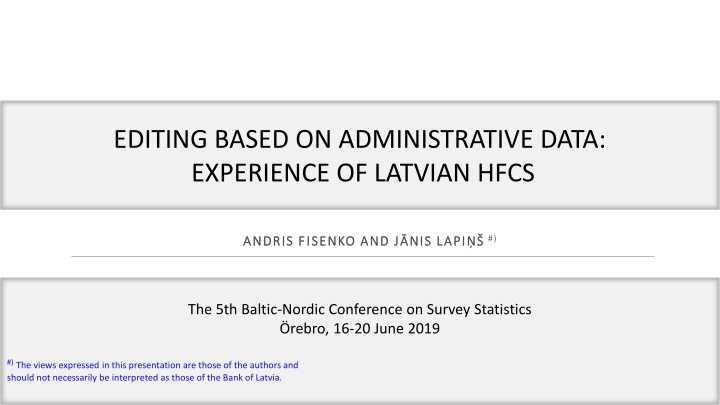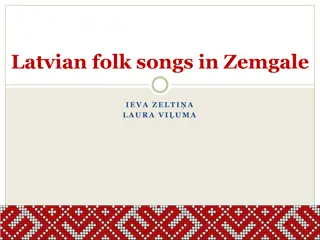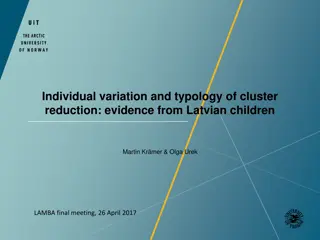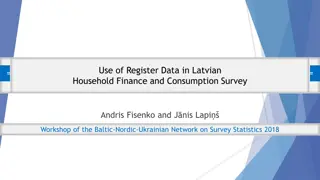Latvian Household Finance and Consumption Survey Experience by Andris Fisenko and J. Nis Lapi
Latvian HFCS, a joint project of Bank of Latvia and Central Statistical Bureau, aims to gather micro-level data on households' assets and liabilities every three years. The survey includes person-level and household-level data, with a focus on economic decisions. Despite a low response rate, the survey provides valuable insights into household finances in Latvia.
Download Presentation

Please find below an Image/Link to download the presentation.
The content on the website is provided AS IS for your information and personal use only. It may not be sold, licensed, or shared on other websites without obtaining consent from the author.If you encounter any issues during the download, it is possible that the publisher has removed the file from their server.
You are allowed to download the files provided on this website for personal or commercial use, subject to the condition that they are used lawfully. All files are the property of their respective owners.
The content on the website is provided AS IS for your information and personal use only. It may not be sold, licensed, or shared on other websites without obtaining consent from the author.
E N D
Presentation Transcript
EDITING BASED ON ADMINISTRATIVE DATA: EXPERIENCE OF LATVIAN HFCS ANDRIS FISENKO AND J NIS LAPI ANDRIS FISENKO AND J NIS LAPI #) The 5th Baltic-Nordic Conference on Survey Statistics rebro, 16-20 June 2019 #)The views expressed in this presentation are those of the authors and should not necessarily be interpreted as those of the Bank of Latvia.
Outline 1.About the HFCS 2.Additional data sources 3.Comparison of collected and final HFCS data 4.Comments 5.References 2
About the HFCS The main aim of the HFCS is to gather micro-level structural information on euro area households' assets and liabilities The survey also collects other information in order to analyse the economic decisions taken by households: Person level data (demographics, employment, pensions and insurance policies, person level income) Household level data (real assets and their financing, other liabilities and credit constraints, private businesses and financial assets, household level income, gifts and inheritances received, consumption) 3
About the HFCS Joint project of the EA countries and some EU countries 1st wave 15 EA countries; 2nd wave 18 EA countries + HU, PL; 3rd wave all EA countries + HU, PL, HR, DK; Data collected every three years Sampling, data collection, editing, imputation done at country level Probability sample design Oversampling of wealthy HHs Harmonized output (i.e., survey data), but not necessarily identical questionnaires commonly agreed set of standardised output variables harmonised methodology for coding the variables multiple imputation for item non-responses 4
About the Latvian HFCS Latvia participated twice in 2014, and in 2017 Joint project of the Bank of Latvia and the Central Statistical Bureau of Latvia Number of responded households 1202 (2014), 1249 (2017) Panel component (668 households participated in both survey waves) Questionnaire (in Latvian, Russian, English) Face-to-face interviews (CAPI 95.5%, CATI 4.5%) In 2017, ECB questions related to the 1-st and 2-nd pension scheme were not included in the Latvian HFCS questionnaire. Data have been obtained from the State Social Insurance Agency (SSIA) 5
The Latvian HFCS, problems Low response rate: 45.3% in 2017 (52.9% in 2014) High (for several variables) item non-response rate (e.g., amount of income for persons having respective type of income): employee income (gross 69%; net 15%), self-employment income 70%/21%, income from public pensions 77%/10%, income from private/occupational pension plans 83%30%, income from unemployment benefits 81%/13% Large percent of wrong answers (ownership of assets, existence of mortgages/loans, insurance contracts, participation in pension plans, income data) Access to and use of administrative/register data 6
Administrative data sources used in 2017 wave Land Cadastre's data on real estate properties that belong to the household members Credit Register data on persons' mortgages, loans and/or leasing contracts State Revenue Service (SRS) data on all type of persons' income in 2016 and data on persons' participation in the voluntary (third level) pension schemes' The State Social Insurance Agency data on persons' participation in the first and second level pension plans 7
What type of person-level income household did received? (HFCS data) "Did you receive income in 2016?" - 1000 of persons No answer Don't know 0.8 0.5 0.0 1.3 0.0 Yes No Total 1,601.1 1,601.1 1,601.1 1,601.1 1,601.1 Employee income Self-employment income Income from public pensions Income from private and occupational pension plans Income from unemployment benefits 0.2 0.4 0.9 1.7 0.0 853.2 87.5 496.9 9.8 35.0 746.8 1,512.7 1,103.3 1,588.3 1,566.0 "Did you receive income in 2016?" - percent No answer Don't know 0.05% 0.03% 0.00% 0.08% 0.00% Yes 53.29% 5.46% 31.03% 0.61% 2.19% No 46.64% 94.48% 68.91% 99.20% 97.81% Total 100.00% 100.00% 100.00% 100.00% 100.00% Employee income Self-employment income Income from public pensions Income from private and occupational pension plans 0.01% 0.02% 0.06% 0.11% 0.00% Income from unemployment benefits 8
Amount of gross employee income (collected vs. final data) Employee income (Million EUR) Employee income received YES YES YES No Don't know No answer Number of HH 16+ members Reported gross amount 2 296.9 Reported net amount Final gross employee income 2 675.9 4 259.1 1 166.2 Amount of employee income Gross income reported Only net income reported Income not reported Question not asked Question not asked Question not asked Total 422 734 205 1 000 0.0 0.0 0.0 0.0 0.0 0.0 3 172.2 0.0 0.0 0.0 0.0 205.2 0.6 10.1 8 317.1 1 2 2 364 2 296.9 3 172.2 9
Amount of gross employee income (collected vs. final data) Employee income (percent) Employee income received YES YES YES No Don't know No answer Number of HH 16+ members 17.9% 31.0% Reported gross amount 27.6% Reported net amount Final gross employee income Amount of employee income Gross income reported Only net income reported Income not reported Question not asked Question not asked Question not asked Total 0.0% 38.1% 0.0% 0.0% 0.0% 0.0% 38.1% 32.2% 51.2% 14.0% 2.5% 0.0% 0.1% 100.0% 0.0% 0.0% 0.0% 0.0% 0.0% 27.6% 8.7% 42.3% 0.0% 0.1% 100.0% 10
Gross employee income per household (1,000 EUR) Net, 5.1 Gross, 2.7 Unknown 6.5 Not reported, 1.4 Not asked, 0.7 Total per HH - 9.9 11
Gross self-employee income per household (1,000 EUR) Gross, 0.2 Net, 0.3 Unknown 0.3 Not asked, 0.3 Not reported, 0.0 Total per HH - 0.8 12
Income from public pensions per household (1,000 EUR) Net, 1.3 Gross, 0.5 Unknown 1.6 Not reported, 0.2 Not asked, 0.1 Total per HH - 2.2 13
Household total gross income: Reported gross income vs. Final data (Mean value, 1,000 EUR) Income Received Weighted Total Income Reported Unknown No Yes Yes All Final Yes Yes No Yes All Reported Final 0.0 0.0 0.0 3.6 3.6 9.0 1.2 0.0 4.1 14.3 Income Received Weighted Total Income (in %) Reported Unknown No Yes Yes All Final Yes Yes No Yes All Reported Final 0.0 0.0 0.0 25.2 25.2 62.9 8.4 0.0 28.7 100.0 14
Household total gross income: Reported (gross or net income) vs. Final data Income Received Weighted Total Income Reported Unknown No Yes Yes All Final Yes Yes No Yes All Reported Final 0.0 0.0 0.0 9.2 9.2 1.8 1.2 0.0 11.2 14.3 Income Received Weighted Total Income (in %) Reported Unknown No Yes Yes All Final Yes Yes No Yes All Reported Final 0.0 0.0 0.0 64.3 64.3 12.6 8.4 0.0 78.3 100.0 15
Real estate properties (Reported values vs. Final data) Number of responded HH Weighted number of HH (*1000) Estimate of population total (Million EUR) Value of real estate properties Reported Yes Unknown Yes No No Final Reported Final Yes 963 85 16 185 1 249 589.2 55.6 10.5 181.5 836.8 27 364.9 1 510.2 30 224.3 4 167.0 106.4 Yes No Total 0.0 0.0 0.0 28 875.1 34 497.7 Percent of responded HH Estimate of population total (percent) Value of real estate properties Percent of weighted HH Reported YES YES No No Final Reported Final Values reported Some values not reported Question not asked Question not asked Total 77.1% 6.8% 1.3% 14.8% 100.0% 70.4% 6.6% 1.3% 21.7% 100.0% 79.3% 4.4% 0.0% 0.0% 83.7% 87.6% 12.1% 0.3% 0.0% 100.0% 16
Property value per household (1,000 EUR) Net, 2.0 Gross, 34.5 Unknown 4.6 Not reported, 2.6 Not asked, 2.2 Total per HH 41.2 17
Outstanding balance of mortgages or loans using property as collateral Number of responded HH Weighted number of HH (*1000) Estimate of population total (Million EUR) Outstanding balance of HB credits Reported Yes Unknown Yes No No Final Reported Final Yes 135 31 34 1 049 1 249 76.2 19.1 20.4 721.1 837 2 260.8 2 700.4 438.2 489.6 7.3 0.0 0.0 Yes No Total 0.0 2 268.1 3 628.2 Percent of responded HH Estimate of population total (percent) Outstanding balance of HB credits Percent of weighted HH Reported YES YES No No Final Reported Final Values reported Some values not reported Question not asked Question not asked Total 10.8% 2.5% 2.7% 84.0% 100.0% 9.1% 2.3% 2.4% 86.2% 100.0% 62.3% 0.2% 0.0% 0.0% 62.5% 74.4% 12.1% 13.5% 0.0% 100.0% 18
Mortgages or loans using property as collateral per household (1,000 EUR) Net, 0.4 Gross, 2.7 Unknown 0.9 Not reported, 0.5 Not asked, 0.7 Total per HH - 4.3 19
Outstanding balance of loans not using property as collateral Outstanding balance of loans not using property as collateral Number of responded HH Weighted number of HH (*1000) Estimate of population total (Million EUR) Reported Yes Unknown Yes No No Final Reported Final Yes 96 17 216 920 1 249 77.5 19.7 144.9 594.7 836.8 242.5 0.1 0.0 0.0 242.6 262.9 125.9 407.7 0.0 796.5 Yes No Total Outstanding balance of loans not using property as collateral Percent of responded HH Estimate of population total (percent) Percent of weighted HH Reported YES YES No No Final Reported Final Values reported Some values not reported Question not asked Question not asked Total 7.7% 1.4% 17.3% 73.7% 100.0% 9.3% 2.4% 17.3% 71.1% 100.0% 30.4% 0.0% 0.0% 0.0% 30.5% 33.0% 15.8% 51.2% 0.0% 100.0% 20
Loans not using property as collateral per household (1,000 EUR) Gross, 0.3 Net, 0.0 Unknown 0.1 Not reported, 0.1 Not asked, 0.5 Total per HH - 0.9 21
Participation in the 3-rd level pension plans and private accumulation contracts together with insurance Persons Value, 1,000 EUR Weighted value, 1,000,000 EUR HFCS Population,*1000 Reported Final Reported Final Unknown 146 79.8 6.5 442.8 1.2 212.7 No 2 015 1 430.9 0.0 654.2 0.0 241.7 Yes 203 90.5 563.8 639.3 155.5 174.8 Total 2 364 1 601.2 570.3 1 736.3 156.7 629.2 22
The 3-rd level pension plans and private accumulation contracts together with insurance(1,000,000 EUR) Survey, 155.5 Imputed, 141.9 Unknown 212.7 Administrative, 70.8 Not asked, 261.0 23
First and second level pension plans Experience from the second wave: Many respondents don't know if they are participants of the pension scheme Only few respondents know current balance of their pension plan account(s) Data obtained from SSIA (participation, annual contribution, current value of pension plan) No imputation needed 24
Comments Usage of register/administrative data allows: to reduce number of questions in the national HFCS questionnaire (e.g., by excluding from the national questionnaire questions related to participation of HH members in the 1-st and the 2-nd level pension plans), to ensure completeness of data and to improve their quality for many HFCS core variables (income, real actives, mortgages and loans, etc.) having high item non-response rates, to eliminate errors in the respondents' incorrectly reported values, to reduce significantly the number of cases, where imputation is needed, at the same time, reaching the better quality of final data than it would be possible by applying the imputation procedures, avoid the need to build for income a net - gross transition model (to calculate gross income for persons, who reported only their net income) 25
References Household Finance and Consumption Network (2016) The Household Finance and Consumption Survey: methodological report for the second wave. ECB Statistical Paper Series, 17. https://www.ecb.europa.eu/pub/economic- research/research-networks/html/researcher_hfcn.en.html https://www.bank.lv/en/statistics/hfcs/tables 26
THANK YOU! 27























